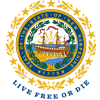Press Release
Contact
(603) 271-3136 | shelly.angers@dncr.nh.gov
NH wildfire risk remains elevated due to extended drought conditions
In its weekly update, the U.S. Drought Monitor announced that drought conditions continue across a vast majority of New Hampshire, with 24 percent of the state currently experiencing severe drought, 2.75 percent suffering from extreme drought conditions and 49 percent designated as being in moderate drought. The state as a whole is 92 percent abnormally dry, which in itself is an indicator of elevated wildfire risk.
“While recent rains have had a positive effect on drought conditions in some parts of the state, the possibility of wildfires remains high across a vast majority of New Hampshire,” said Chief Steven Sherman of the N.H. Forest Protection Bureau. “We’d like to remind everyone to stay actively engaged in reducing wildfire risk so that we can all enjoy a beautiful and safe fall season.”
Ninety percent of wildfires in New Hampshire are human caused. Most often they start from campfires, brush fires or other planned fires, but other heat sources – like vehicle engines and lawncare equipment – can overheat or cause sparks, burning dry fuels on contact and starting a wildfire.
Anyone wishing to have a campfire or other category of fire in New Hampshire may obtain a burn permit at nhfirepermit.com or from the local jurisdiction where the fire will take place.
“As days grow shorter and people get in those last cookouts and camping trips, it’s incredibly important that they make sure any fire they have is what we call ‘dead out,’ which means drowning it with water, stirring the embers and then using a bare hand to make sure that what remains of their fire is cool to the touch,” said Sherman.
“Even a little bit of warmth means that heat is still present, and that can grow and cause a wildfire even hours after everyone’s gone home.”
New Hampshire averages 250 wildfires a year with 250 acres impacted. Two large wildfires this spring, the Centennial Fire in Shelburne and the Bemis Fire in Crawford Notch, resulted in a total of 153 acres of damage.
While New Hampshire tends to see elevated wildfire risk in the spring when dried leaves and other forest floor litter are abundant and trees have not yet greened up, a second increase in wildfires often happens in the fall, especially when drought conditions are high.
The N.H. Forest Protection Bureau is part of the Department of Natural and Cultural Resources’ Division of Forests and Lands, which protects and promotes the value provided by trees, forests and natural communities. For more information about the Division of Forests and Lands and the work of its Forest Protection Bureau, visit nhdfl.dncr.nh.gov or call 603-271-2214.
###



